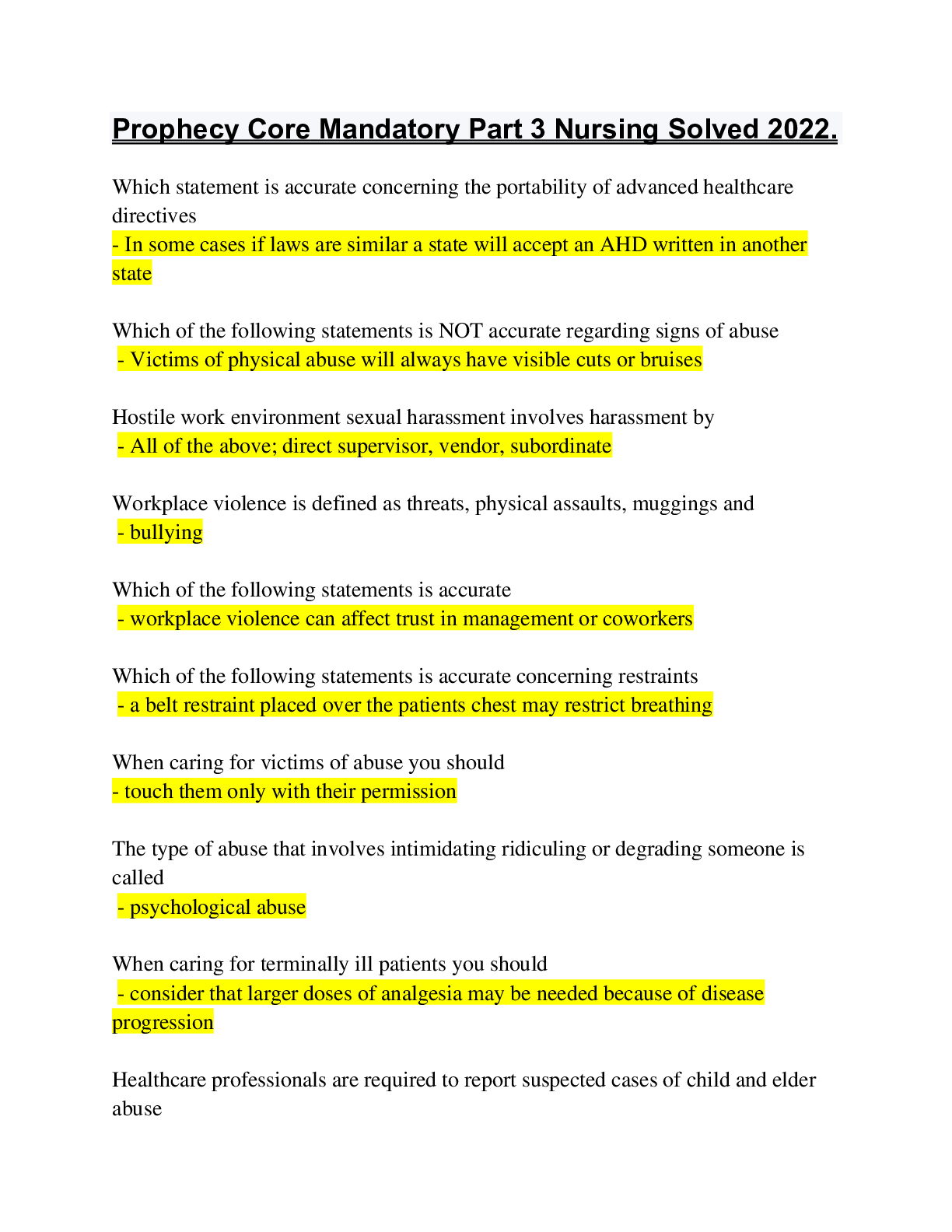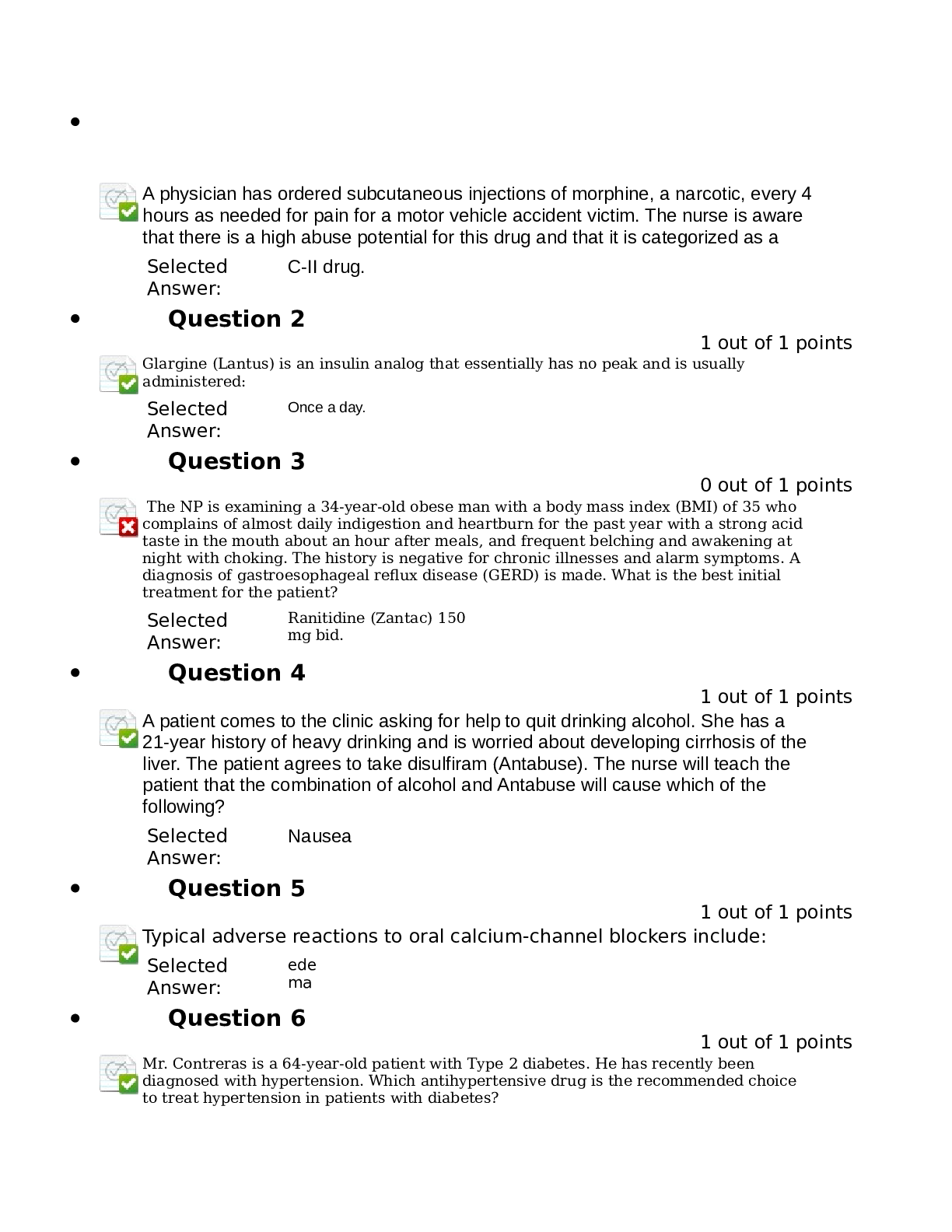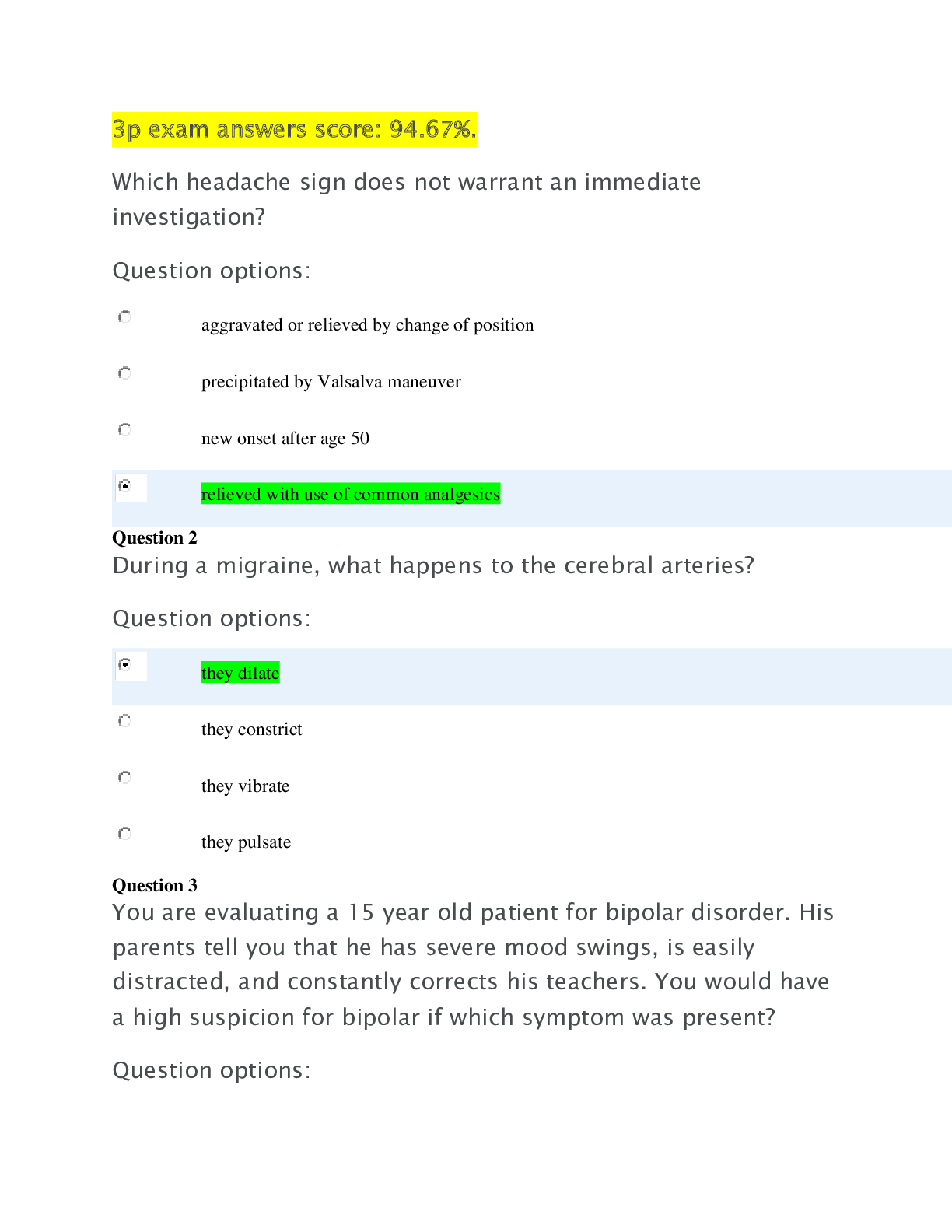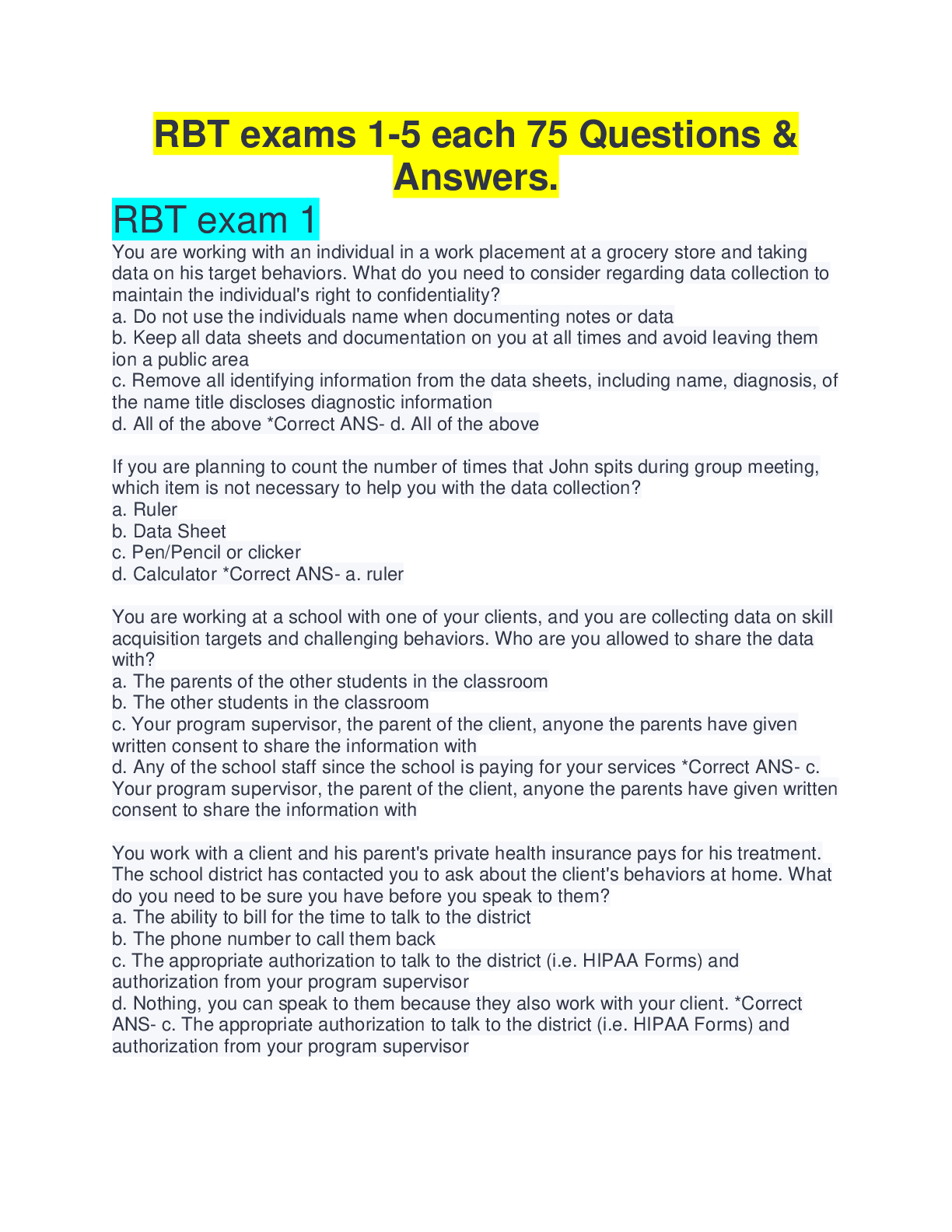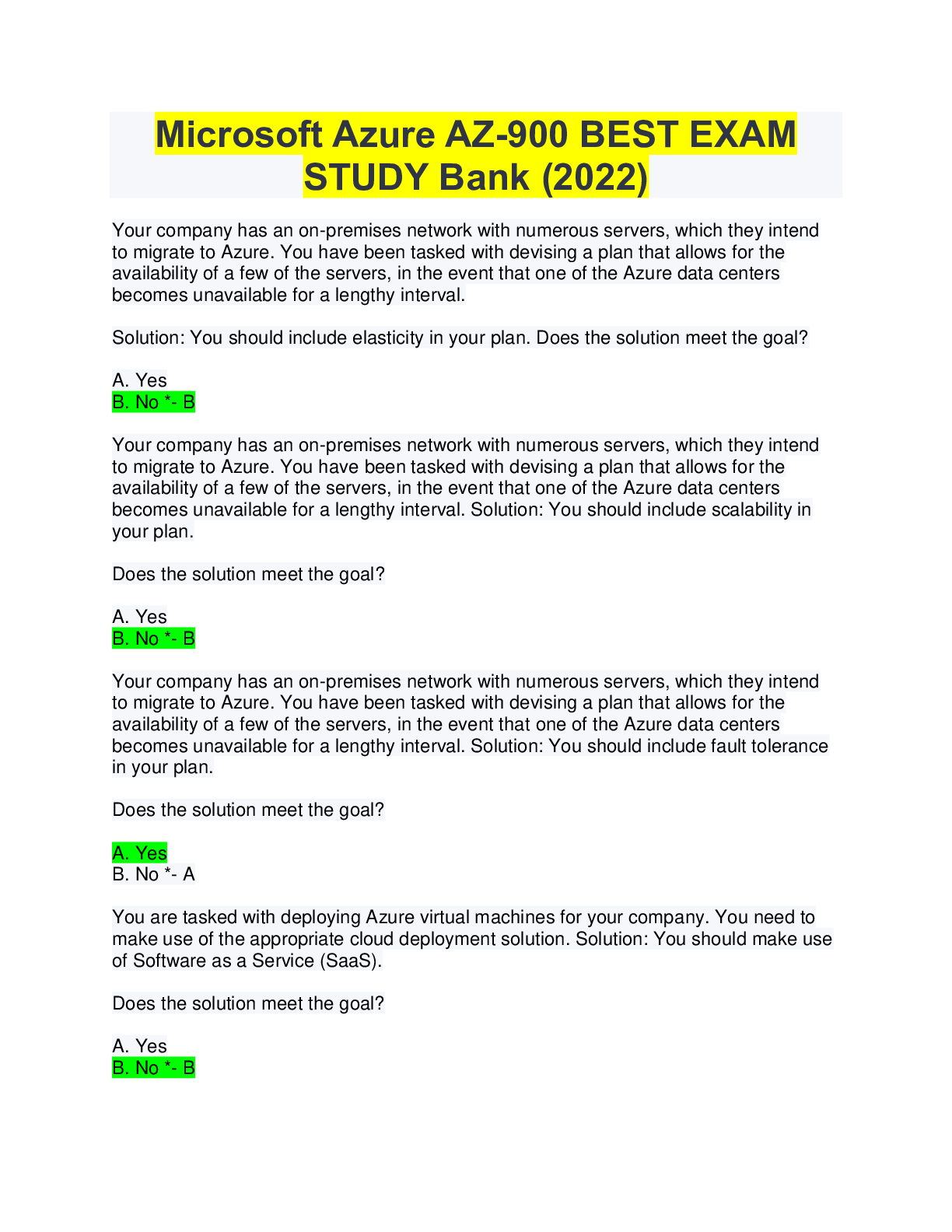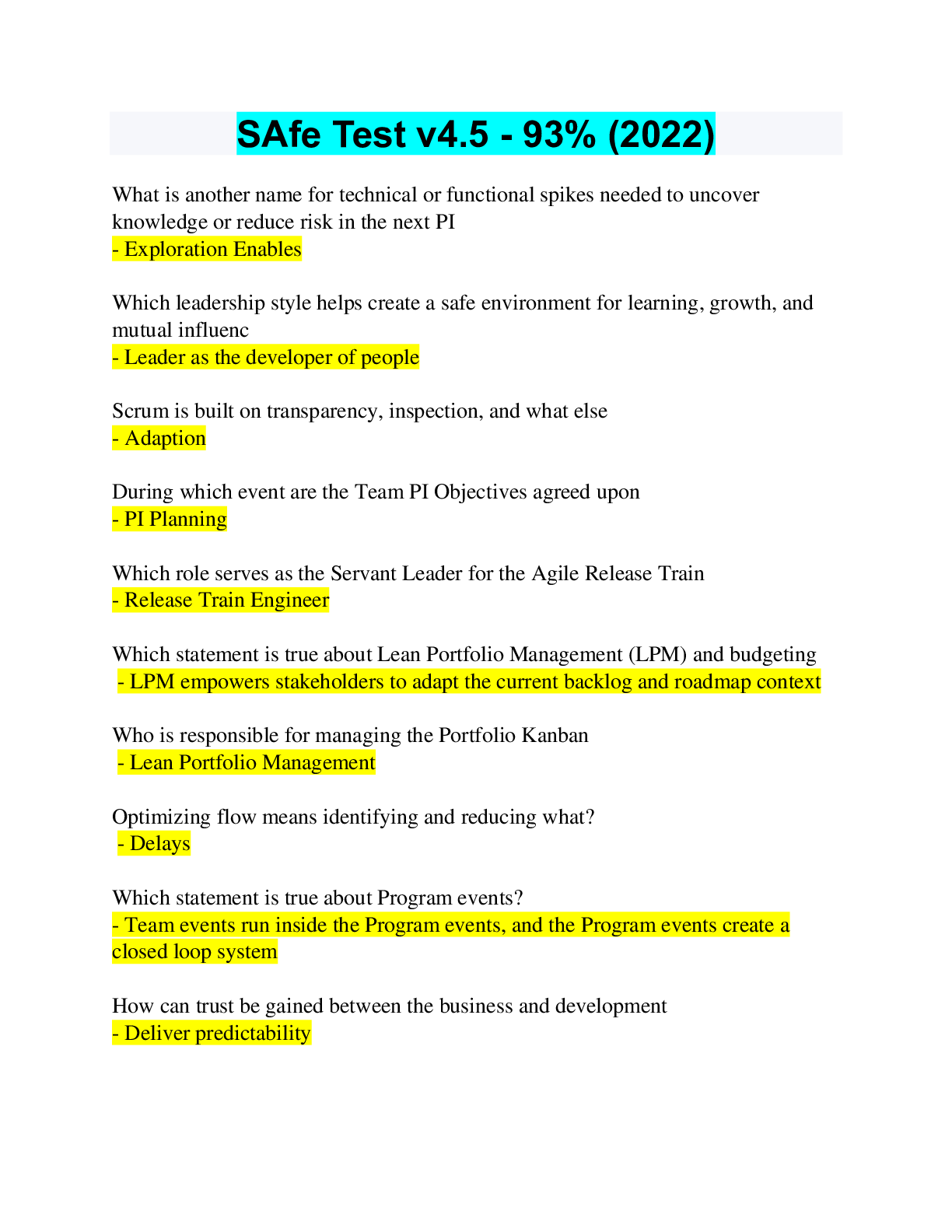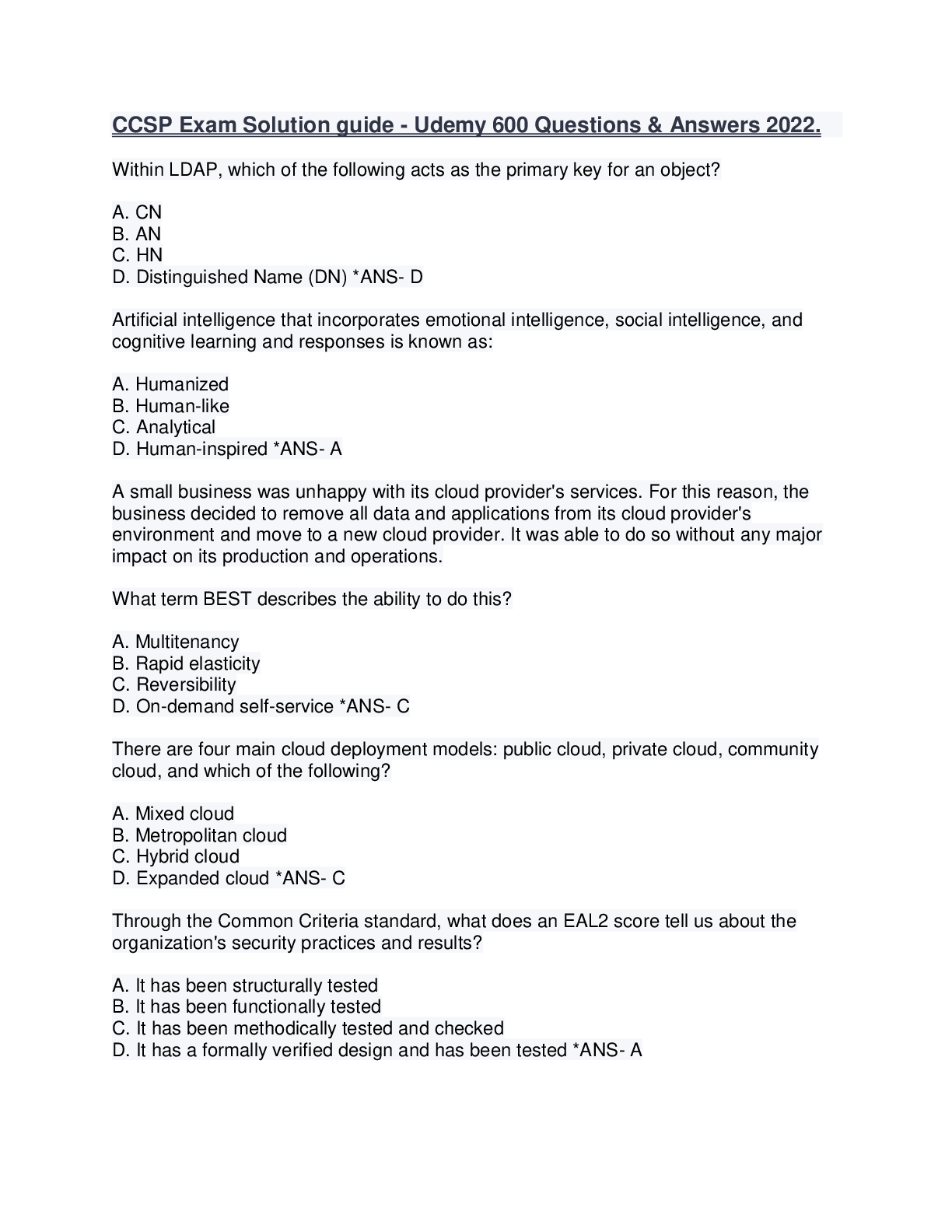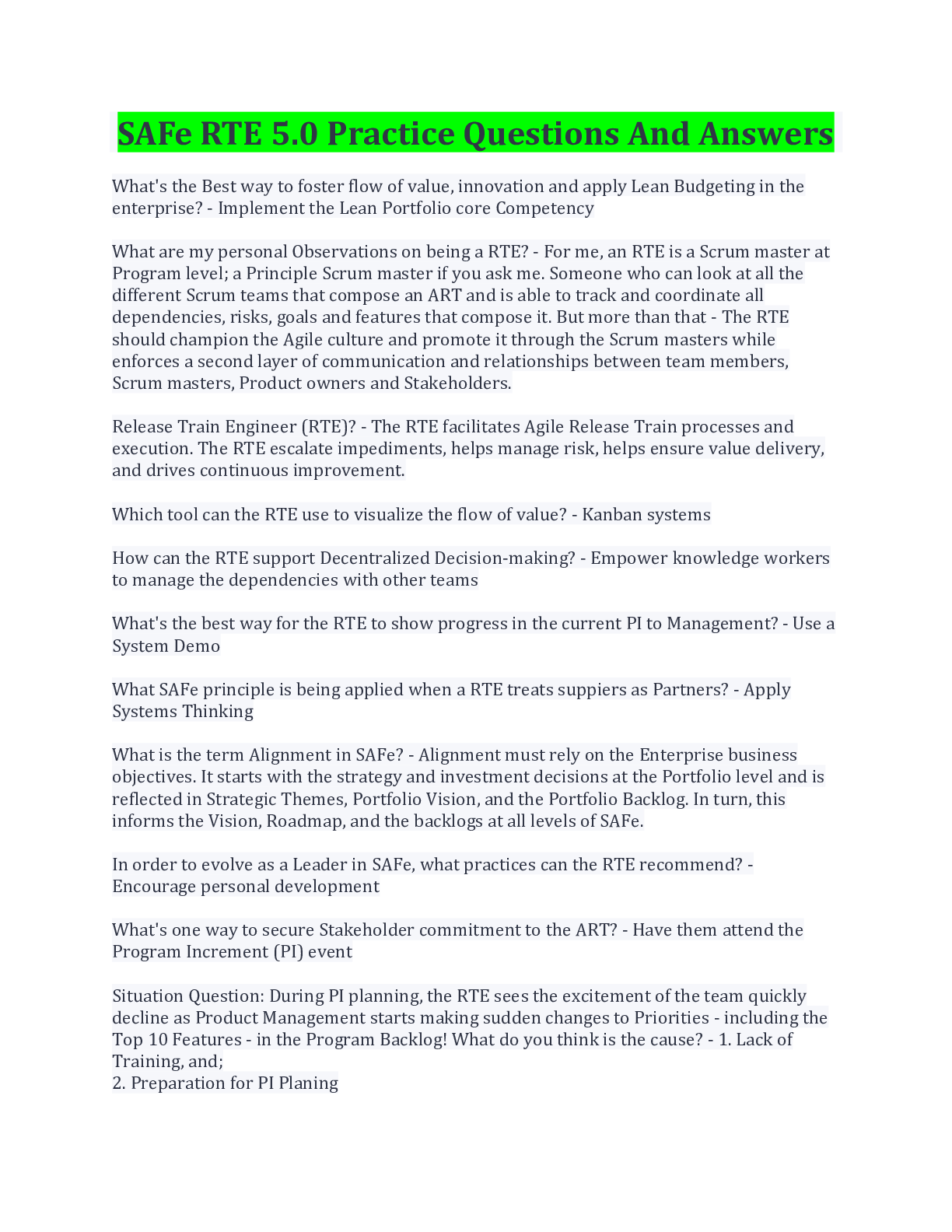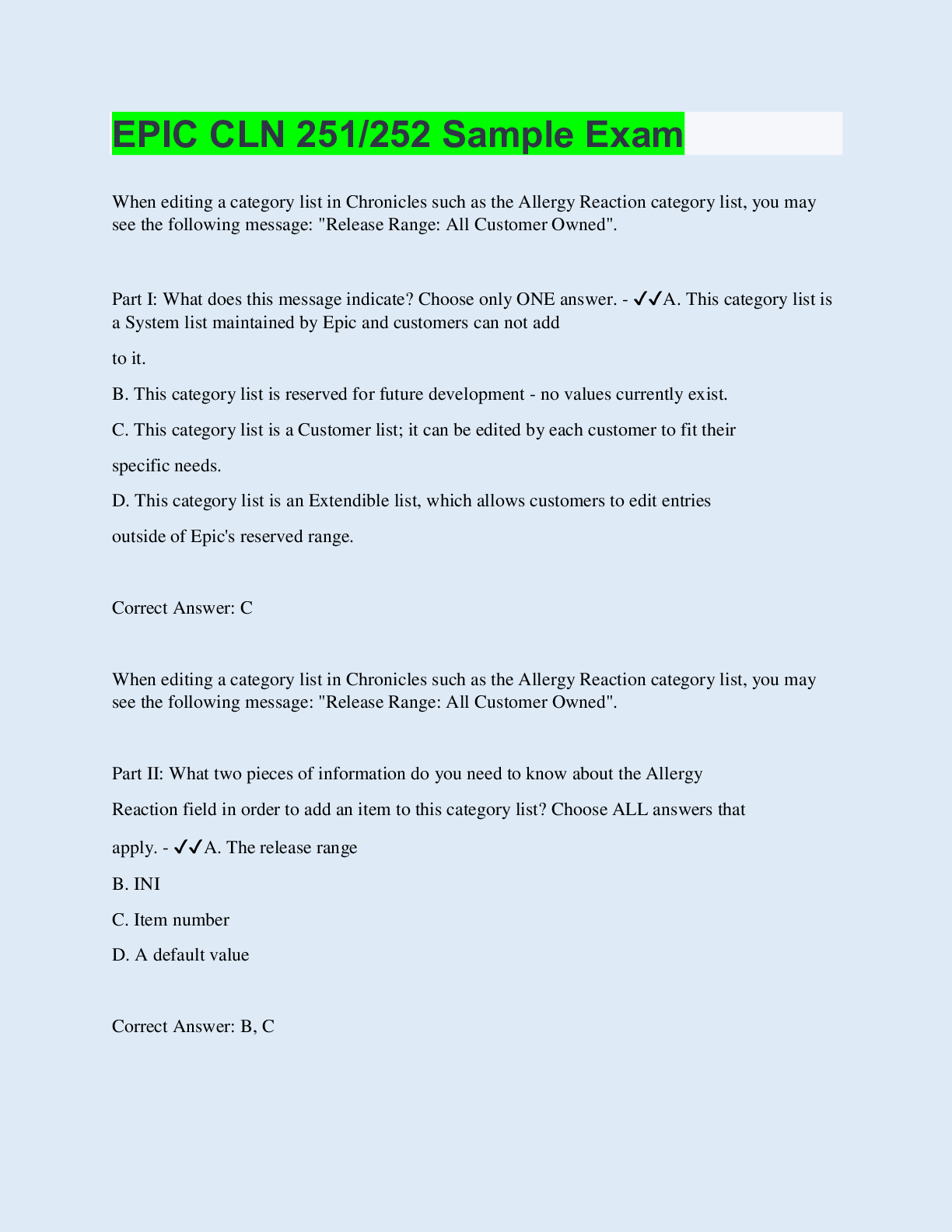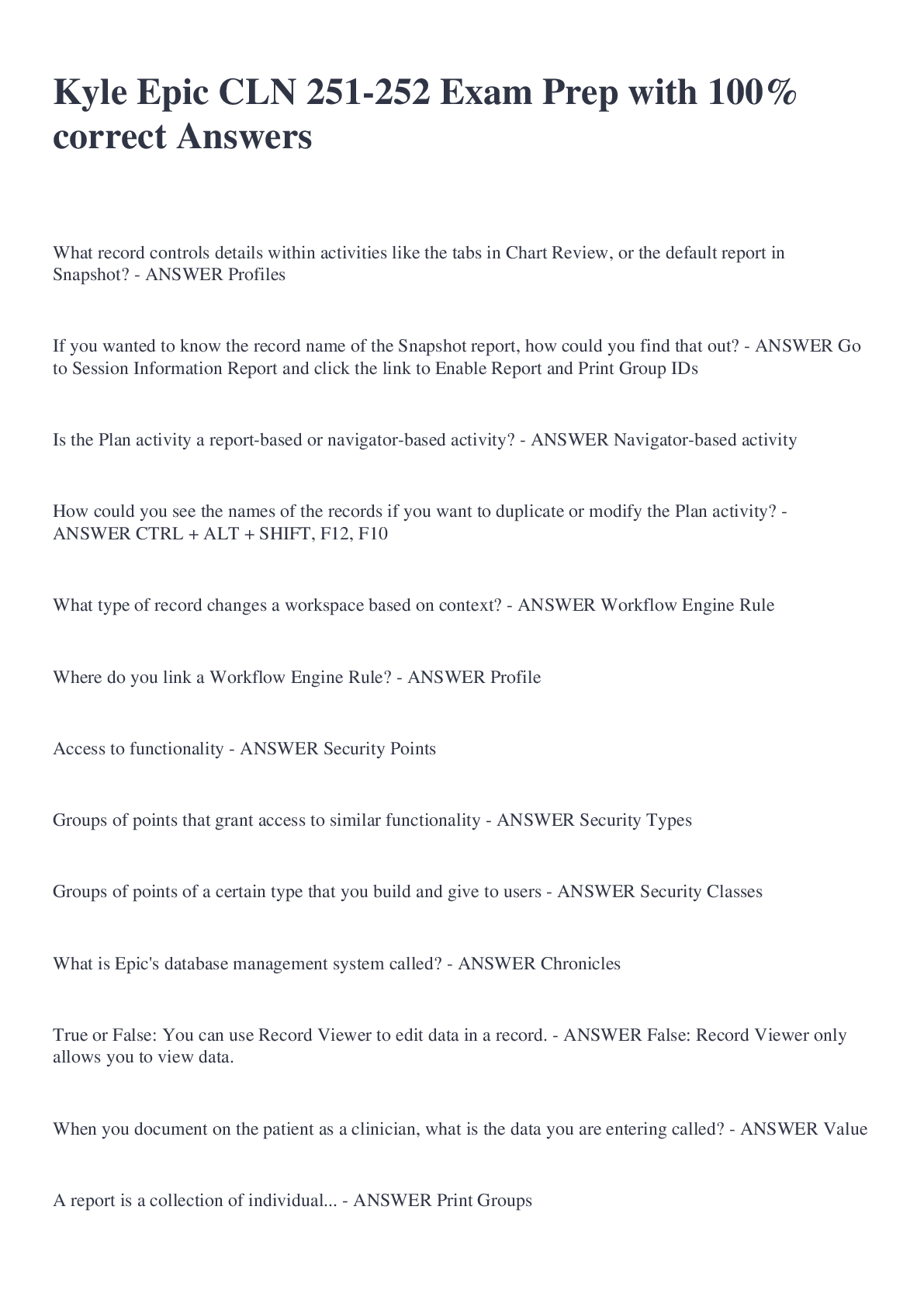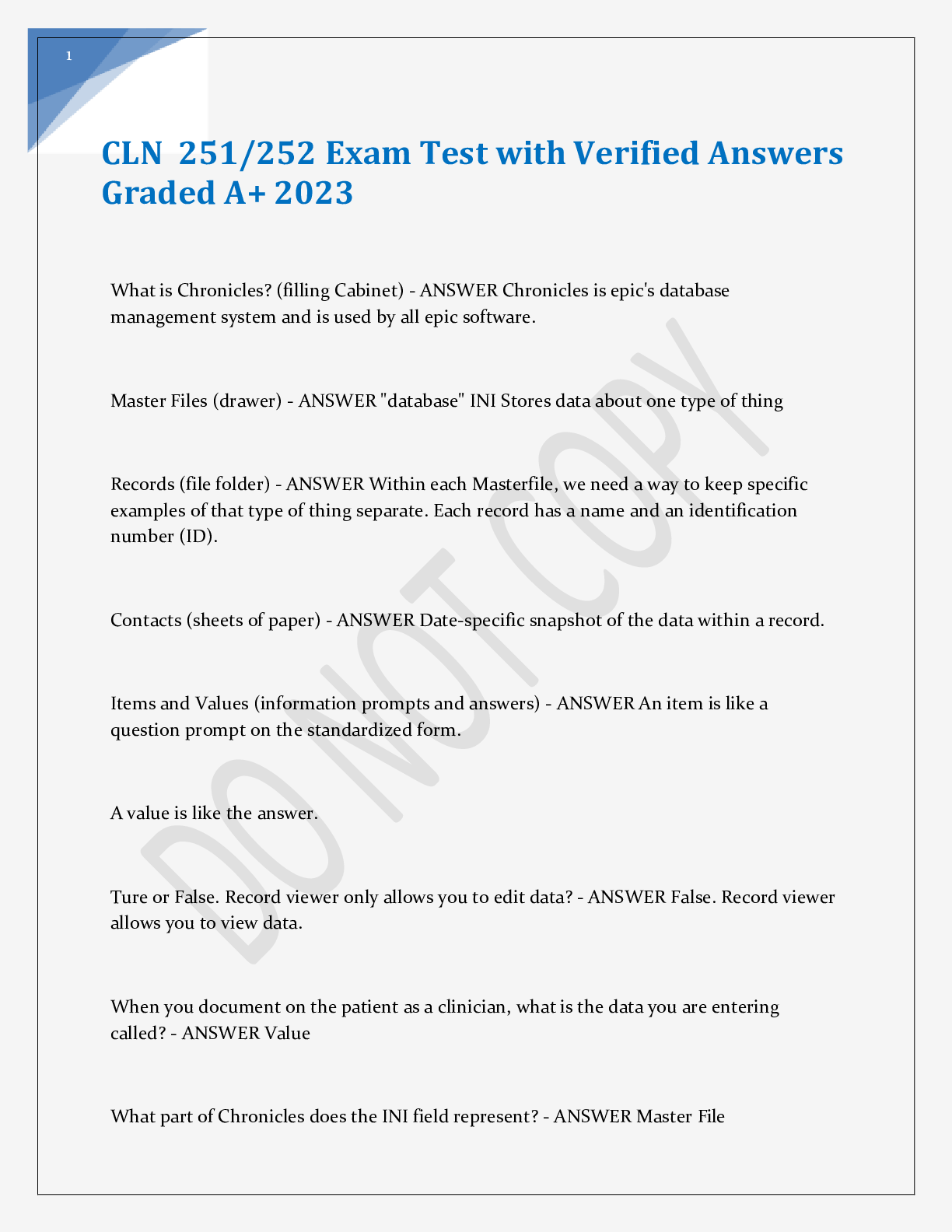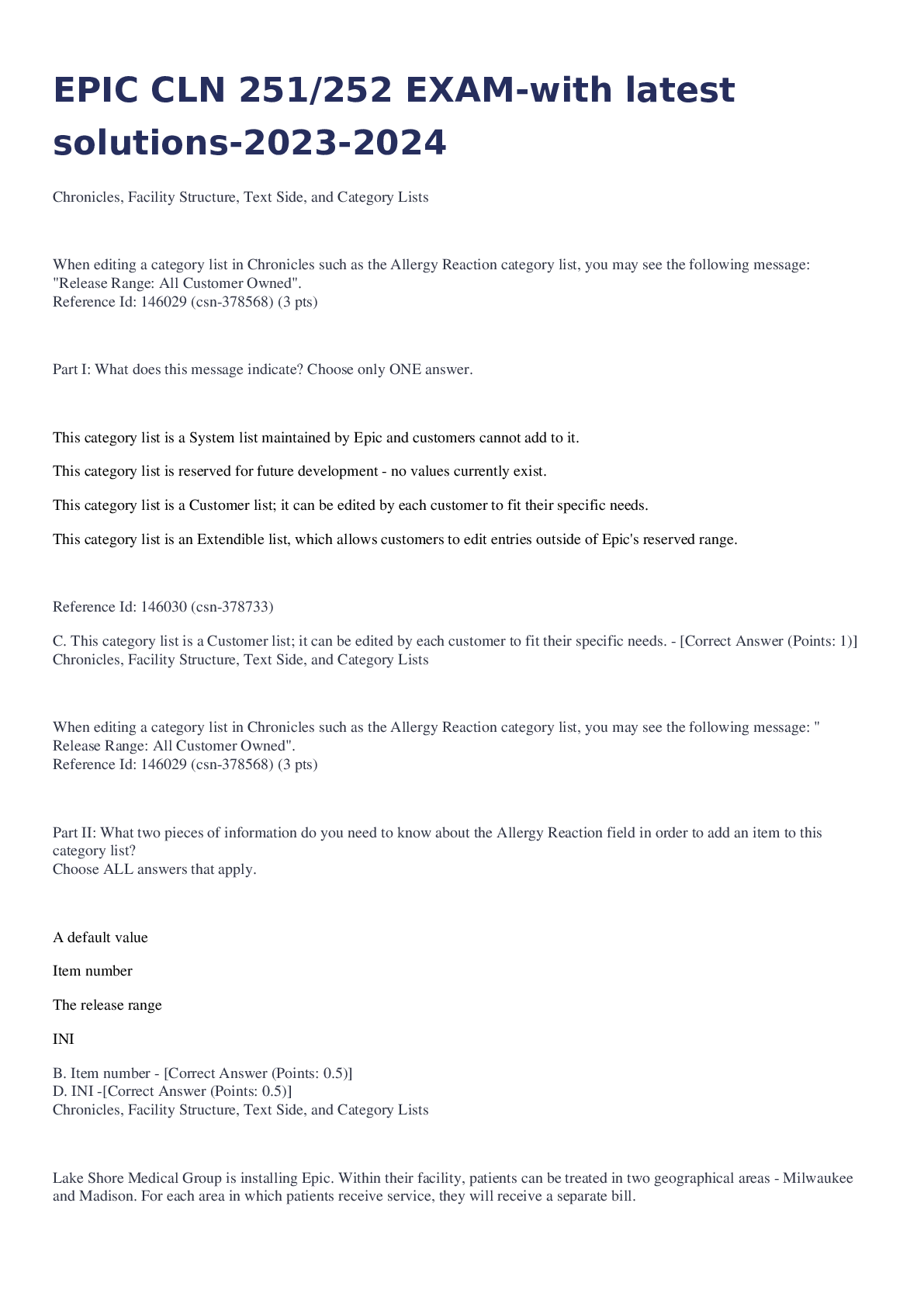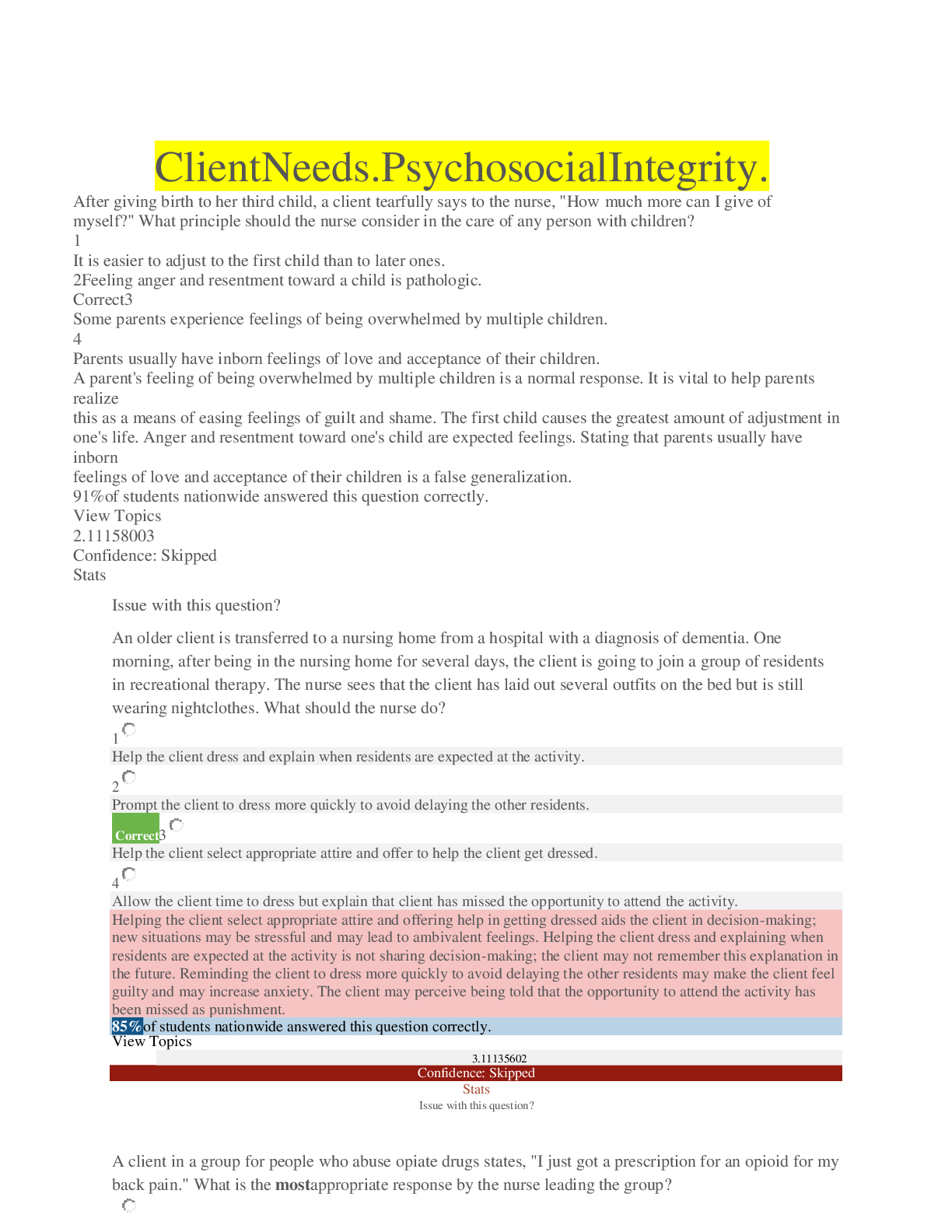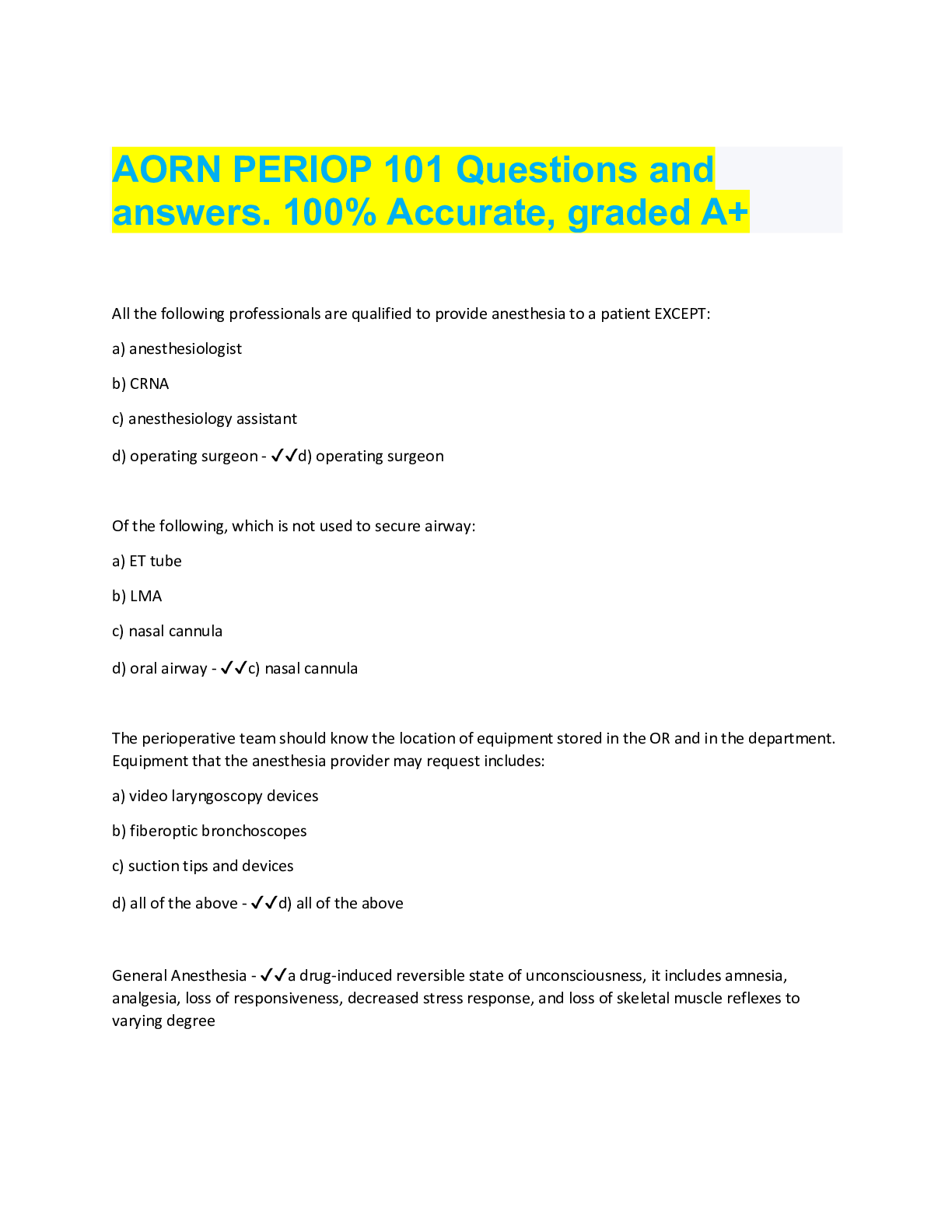Pathophysiology module 16 exam > Answered (complete latest Fall 2020/2021)
Document Content and Description Below
Pathophysiology module 16 exam > Answered (complete latest Fall 2020/2021) NR 507Week 7 Quiz 1. A patient breaks a bone in a place where there was a pre-existing disease. Which type of fractur... e is being described? A) Transchondral Feedback: A transchondral fracture involves the fragmentation and separation of a portion of the articular cartilage that covers the end of a bone or a joint. A pathologic fracture occurs in a place where there was pre-existing disease that weakened the area. B) Pathological Feedback: A pathologic fracture occurs in a place where there was pre-existing disease that weakened the area. C) Stress Feedback: A stress fracture occurs where the bone is exposed to repeated environmental stressors during sports or other types of activities. A pathologic fracture occurs in a place where there was pre-existing disease that weakened the area. D) Fatigue Feedback: Fatigue fractures occur when there is an imbalance between newly developed muscle tissue and new bone formation. A pathologic fracture occurs in a place where there was pre-existing disease that weakened the area. 2. Which statement indicates a nurse needs more teaching about bone healing? An event that occurs following a bone fracture is: A) development of a blood clot in the medullary canal. Feedback: Bone fractures result in ruptured vessels, bleeding, and later clot formation at the site of injury. Osteoblasts migrate to the site of injury to repair the fractured bone tissue. B) leukocyte infiltration into bone tissue. Feedback: Following a fracture, leukocytes and mast cells infiltrate into bone tissue to facilitate the healing process. Osteoblasts migrate to the site of injury to repair the fractured bone tissue. C) blood vessel growth at the fracture site. Feedback: Tissue injury stimulates the growth of new blood vessels to promote healing. Osteoblasts migrate to the site of injury to repair the fractured bone tissue. D) an increase in the number of osteoclasts at the fracture site. Feedback: Osteoblasts migrate to the site of injury to repair the fractured bone tissue. 3. A nurse is describing the pathophysiology of a torus fracture. Which information should the nurse include? A torus fracture is a type of: A) complete fracture. Feedback: In a complete fracture the bone is broke entirely through. A torus fracture is a type of incomplete fracture that occurs when the cortex of the bone buckles, but does not break. B) incomplete fracture. Feedback: A torus fracture is a type of incomplete fracture that occurs when the cortex of the bone buckles, but does not break. C) fracture that breaks through the entire bone. Feedback: A complete fracture involves the entire bone. A torus fracture is a type of incomplete fracture that occurs when the cortex of the bone buckles, but does not break. D) fracture that occur straight across the bone. Feedback: A transverse fracture occurs straight across the bone. A torus fracture is a type of incomplete fracture that occurs when the cortex of the bone buckles, but does not break. 4. A patient has a fracture that broke into several fragments. Which type of fracture did the patient sustain? A) Comminuted fracture Feedback: A fracture in which the bone breaks into two or more fragments is called a comminuted fracture. B) Open fracture Feedback: An open fracture refers to an injury in which the skin is broken at the site of the fracture by fragments of bone. A fracture in which the bone breaks into two or more fragments is called a comminuted fracture. C) Greenstick fracture Feedback: A greenstick fracture involves a small break in the cortex of the bone. A fracture in which the bone breaks into two or more fragments is called a comminuted fracture. D) Occult fracture Feedback: An occult fracture is one that is not readily visible and therefore usually does not involve bone fragmentation and separation. A fracture in which the bone breaks into two or more fragments is called a comminuted fracture. 5. An adolescent patient has sustained a fracture that involves fragmentation of the articular cartilage. Which type of fracture did the adolescent sustain? A) Greenstick Feedback: Greenstick fractures occur most often in the growing bones of children and do not involve the articular cartilage. Transchondral fractures (chondral = cartilage) involve the separation of the articular cartilage from the bone and typically occur in adolescents. B) Stress Feedback: Stress fractures are caused by excessive repetitive forces and generally occur in athletes of all ages. Transchondral fractures (chondral = cartilage) involve the separation of the articular cartilage from the bone and typically occur in adolescents. C) Transchondral Feedback: Transchondral fractures (chondral = cartilage) involve the separation of the articular cartilage from the bone and typically occur in adolescents. D) Insufficiency Feedback: Insufficiency fractures occur in individuals with chronic diseases such as rheumatoid arthritis, osteoporosis, and Paget disease. Transchondral fractures (chondral = cartilage) involve the separation of the articular cartilage from the bone and typically occur in adolescents. 6. Which of the following assessment symptoms are typical in a patient who has just sustained a femoral fracture? A) Chest pain and shortness of breath Feedback: Chest pain and breathing problems are not typical symptoms of a lower limb fracture. Because of inflammation, a fracture generally manifests with pain and swelling at the site of injury. B) Low blood glucose and seizures Feedback: Limb fractures do not lower blood glucose levels, although they may rise because of physiological stress. Limb fractures do not induce seizure activity, although the brain injuries sustained with a skull fracture could result in neurological problems. Because of inflammation, a fracture generally manifests with pain and swelling at the site of injury. C) Pain and swelling in the thigh Feedback: Because of inflammation, a fracture generally manifests with pain and swelling at the site of injury. D) Limb paralysis and referred pain Feedback: Although a fractured limb is immobilized because of pain and misalignment, mobility is impaired but it is not paralyzed. Generally, only visceral pain is referred. Because of inflammation, a fracture generally manifests with pain and swelling at the site of injury. 7. Which complication should the nurse assess for in a patient who had improper immobilization of a fracture? A) Disunion Feedback: Disunion is not a type of complication. Malunion is a complication that occurs when the bone fails to align ly during the healing process. B) Aunion Feedback: Aunion is not a type of complication. Malunion is a complication that occurs when the bone fails to align ly during the healing process. C) Malunion Feedback: Malunion is a complication that occurs when the bone fails to align ly during the healing process. D) Imunion Feedback: Imunion is not a type of complication. Malunion is a complication that occurs when the bone fails to align ly during the healing process. 8. A nurse is describing the pathophysiology of bone healing. Which information should the nurse include? Factor(s) that can prevent proper bone healing include: A) vitamins C and E. Feedback: Vitamins A, C, D, and K promote bone tissue healing. Alcohol and nicotine can delay proper bone healing. B) alcohol and nicotine. Feedback: Alcohol and nicotine can delay proper bone healing. C) high-protein diet. Feedback: Protein is necessary for forming the collagen matrix in healing bone. Malnutrition can delay bone healing. Alcohol and nicotine can delay proper bone healing. D) dehydration. Feedback: Fluid status is not an important determinant in bone healing. Alcohol and nicotine can delay proper bone healing. 9. A patient has a tear in the tendon. Which diagnosis will the nurse observe documented on the chart? A) Fracture Feedback: A fracture is a break in the bone. A strain is a tear in a tendon. B) Sprain Feedback: A sprain is a tear in the ligament. A strain is a tear in a tendon. C) Strain Feedback: A strain is a tear in a tendon. D) Subluxation Feedback: Subluxation is a type of synovial joint injury. A strain is a tear in a tendon. 10. A nurse is providing care to a patient that has a tendon torn from the bone. Which term will the nurse use to describe this condition? A) Avulsion Feedback: A complete separation of a tendon or ligament from its bony attachment site is known as an avulsion. B) Arthritis Feedback: Arthritis is inflammation in a joint. A complete separation of a tendon or ligament from its bony attachment site is known as an avulsion. C) Delta lesions Feedback: Delta lesions are microscopic holes in the sarcolemma membrane and occur with myoglobinuria (rhabdomyolysis). A complete separation of a tendon or ligament from its bony attachment site is known as an avulsion. D) Bursitis Feedback: Bursitis is inflammation of the bursal sacs that protect the skin over bony protuberances. A complete separation of a tendon or ligament from its bony attachment site is known as an avulsion. 11. A patient has a partial/incomplete tear of a ligament. Which term will the nurse use to describe this condition? A) First-degree sprain Feedback: A first-degree sprain involves only minor tearing of ligamentous fibers. A second-degree sprain involves partial tearing of a ligament. B) Second-degree sprain Feedback: A second-degree sprain involves partial tearing of a ligament. C) First-degree strain Feedback: A strain is a tendon injury. A second-degree sprain involves partial tearing of a ligament. D) Second-degree strain Feedback: A strain is a tendon injury. A second-degree sprain involves partial tearing of a ligament. 12. A patient has a set of pins connected to stabilizing bars on the outside of the patient. The nursing is providing care to a patient who has undergone: A) open reduction. Feedback: Open reduction is a surgical procedure that exposes the fracture site; the fragments are manipulated into alignment under direct visualization. A set of pins connected to stabilizing bars on the outside of the patient is a type of treatment for fractures called external fixation. B) closed manipulation. Feedback: A set of pins connected to stabilizing bars on the outside of the patient is a type of treatment for fractures called external fixation. C) external fixation. Feedback: A set of pins connected to stabilizing bars on the outside of the patient is a type of treatment for fractures called external fixation. D) skin traction. Feedback: Skin traction involves traction applied to the skin. A set of pins connected to stabilizing bars on the outside of the patient is a type of treatment for fractures called external fixation. 13. A patient has displacement of two bones in which the articular surfaces partially lose contact with each other. The nurse is providing care to a patient with a: A) subluxation. Feedback: The displacement of two bones in which the articular surfaces partially lose contact with each other is called subluxation. Subluxation results in joint deformity, immobility, and pain. B) subjugation. Feedback: Subjugation is not a type of bone injury. The displacement of two bones in which the articular surfaces partially lose contact with each other is called subluxation. C) sublimation. Feedback: Sublimation is not a type of bone injury. The displacement of two bones in which the articular surfaces partially lose contact with each other is called subluxation. D) dislocation. Feedback: The displacement of two bones in which the articular surfaces partially lose contact with each other is called subluxation. Dislocation occurs when the articular surfaces of the bones lose complete contact with each other. 14. Patients with osteoporosis should be assessed by the nurse for the risk of: A) rhabdomyolysis. Feedback: Osteoporosis weakens the bone structure and increases the risk of fracture. Rhabdomyolysis occurs with skeletal muscle trauma. B) osteomyelitis. Feedback: Osteoporosis weakens the bone structure and increases the risk of fracture. Osteoarthritis does not increase the risk of osteomyelitis. C) osteomalacia. Feedback: Osteoporosis and osteomalacia both manifest with weakened bone structure and increased risk of fracture. Development of osteomalacia is not related to the pathology of osteoporosis. D) pathologic bone fractures. Feedback: Osteoporosis weakens the bone structure and increases the risk of fracture. 15. A patient has researched menopause and osteoporosis on the internet. Which information indicates the patient has a good understanding? Factors contributing to the development of osteoporosis in older women (menopausal) include: A) decreased estrogen levels. Feedback: The hormone estrogen helps maintain bone strength and integrity in women. In menopause, decreased estrogen production increases a woman's risk of developing osteoporosis. B) increased androgen levels. Feedback: Increased androgen levels would promote bone integrity and strength. In menopause, decreased estrogen production increases a woman's risk of developing osteoporosis. C) excessive dietary calcium. Feedback: Decreased calcium intake is associated with the development of osteoporosis. In menopause, decreased estrogen production increases a woman’s risk of developing osteoporosis. D) strenuous exercise. Feedback: Strenuous, weight-bearing exercise can help prevent osteoporosis. In menopause, decreased estrogen production increases a woman’s risk of developing osteoporosis. 16. A nurse is discussing the risk factors for osteoporosis. Which information is ? A known cause of osteoporosis includes: A) late menopause. Feedback: Early menopause is a risk factor for osteoporosis. Thin build is a risk factor for osteoporosis. B) thin build. Feedback: Thin build is a risk factor for osteoporosis. C) not smoking. Feedback: Smoking can increase the risk of developing osteoporosis. Thin build is a risk factor for osteoporosis. D) hypophosphatemia. Feedback: Too much phosphorus has been linked to osteoporosis. Thin build is a risk factor for osteoporosis. 17. A nurse is asked what is a common diagnostic test for osteoporosis. How should the nurse respond? A common screening test for osteoporosis is: A) an x-ray. Feedback: Although an x-ray can show pathological fractures from osteoporosis, early detection of osteoporosis requires a DEXA scan. B) a bone biopsy. Feedback: Bone biopsies are used to diagnose osteomalacia. A DEXA scan is the most useful test for evaluating bone density if osteoporosis is suspected. C) a dual energy x-ray absorptiometry (DEXA) scan. Feedback: A DEXA scan is the most useful test for evaluating bone density if osteoporosis is suspected. D) a thorough physical exam. Feedback: Although a physical exam is always a component of evaluation, osteoporosis cannot be diagnosed without a DEXA scan. 18. A nurse is discussing a disorder that presents with significant bone demineralization from a vitamin D deficiency and usually results in skeletal pain. Which disorder is the nurse describing? A) Osteomalacia Feedback: Osteomalacia is a rare metabolic disease characterized by inadequate mineralization of bone tissue in compact and spongy bone. The most common cause of osteomalacia is vitamin D deficiency. B) Osteopenia Feedback: Osteopenia is an early stage of osteoporosis defined by a mild to moderate decrease in bone mass. Osteopenia is not caused by vitamin D deficiency nor does it generally result in skeletal pain. Osteomalacia is a rare metabolic disease characterized by inadequate mineralization of bone tissue in compact and spongy bone. The most common cause of osteomalacia is vitamin D deficiency. C) Osteomyelitis Feedback: Osteomyelitis is an infectious bone disease. Osteomalacia is a rare metabolic disease characterized by inadequate mineralization of bone tissue in compact and spongy bone. The most common cause of osteomalacia is vitamin D deficiency. D) Osteoporosis Feedback: Osteoporosis results from bone demineralization but differs from osteomalacia in its etiology. Osteomalacia results in decreased bone density that is due to vitamin D deficiency. 19. A patient has osteomyelitis. When the nurse is reviewing the lab results, which organism will the nurse most likely observe on the report? A) Fungus Feedback: Osteomyelitis is a bone infection most often caused by bacteria; however, fungi, parasites, and viruses also can cause bone infection. B) Parasite Feedback: Osteomyelitis is a bone infection most often caused by bacteria; however, fungi, parasites, and viruses also can cause bone infection. C) Virus Feedback: Osteomyelitis is a bone infection most often caused by bacteria; however, fungi, parasites, and viruses also can cause bone infection. D) Bacteria Feedback: Osteomyelitis is a bone infection most often caused by bacteria. 20. A nurse is describing the pathophysiology of osteomalacia. Which information should the nurse include? The pathophysiology of osteomalacia involves: A) increased concentration of phosphate serum levels. Feedback: Although the increase in circulating PTH level raises the plasma calcium concentration, it also stimulates increased renal clearance of phosphate. Low plasma calcium levels stimulate increased synthesis and secretion of PTH. B) collagen breakdown in the bone matrix. Feedback: Collagen breakdown in bone tissue is seen in certain endocrine disorders such as hypercortisolism. Low plasma calcium levels stimulate increased synthesis and secretion of PTH. C) osteoclast activity that is increased. Feedback: Increased osteoclastic activity is seen in osteoporosis. Low plasma calcium levels stimulate increased synthesis and secretion of PTH. D) low calcium levels and secretion of parathyroid hormone (PTH). Feedback: Low plasma calcium levels stimulate increased synthesis and secretion of PTH. 21. If osteomalacia occurs in the growing bones of a child, which of the following diseases will the nurse use to describe this condition? A) Rickets Feedback: Rickets is a form of osteomalacia caused by a vitamin D deficiency which results in soft, deformable bones in children. B) Osteosarcoma Feedback: Osteosarcoma is a form of bone cancer and is not similar to osteomalacia. Rickets is a form of osteomalacia caused by a vitamin D deficiency which results in soft, deformable bones in children. C) Paget disease Feedback: Paget disease is an apparent genetic disorder characterized by enlarged and softened bones. Rickets is a form of osteomalacia caused by a vitamin D deficiency which results in soft, deformable bones in children. D) Rhabdomyoma Feedback: Rhabdomyoma is a muscle tumor. Rickets is a form of osteomalacia caused by a vitamin D deficiency which results in soft, deformable bones in children. 22. A patient has a disorder that is characterized by enlargement and softening of the bones. Which disease does the patient have? A) Osteomyelitis Feedback: Osteomyelitis is a bone infection. Paget disease (osteitis deformans) is characterized by excessive bone resorption and formation, resulting in chronic enlargement and softening of certain bones. B) Osteoporosis Feedback: Osteoporosis, or porous bone, is a complex, multifactorial, chronic disease that often progresses silently for decades until fractures occur. Paget disease (osteitis deformans) is characterized by excessive bone resorption and formation, resulting in chronic enlargement and softening of certain bones. C) Paget disease Feedback: Paget disease (osteitis deformans) is characterized by excessive bone resorption and formation, resulting in chronic enlargement and softening of certain bones. D) Rickets Feedback: Rickets is similar to osteomalacia in pathogenesis, but it occurs in the growing bones of children, whereas osteomalacia occurs in adult bone. Paget disease (osteitis deformans) is characterized by excessive bone resorption and formation, resulting in chronic enlargement and softening of certain bones. 23. A nurse is asked what causes endogenous osteomyelitis. What is the nurses best response? The cause of most cases of endogenous osteomyelitis is (are): A) fungal skin infection. Feedback: Fungal infections of the skin are a rare cause of exogenous osteomyelitis. Endogenous osteomyelitis is caused by blood-borne infections. B) viral pneumonia. Feedback: Viral pneumonias are not a common cause of osteomyelitis. Endogenous osteomyelitis is caused by blood-borne infections. C) parasitic infection from a dog bite. Feedback: Infection from a dog bite is a type of exogenous osteomyelitis. Endogenous osteomyelitis is caused by blood-borne infections. D) blood-borne bacteria. Feedback: Endogenous osteomyelitis is caused by blood-borne infections. The specific causative organisms differ among age and population groups. 24. A patient has a tumor that causes a moth eaten appearance in the bone. A nurse suspects the patient has which of the following musculoskeletal tumors? A) Rhabdosarcoma Feedback: Rhabdosarcomas are malignant tumors that form in skeletal muscle tissue. Though considered a bone-forming tumor (osteogenic cells), the radiologic appearance of sarcoma is quite variable and often shows a moth-eaten (lytic) pattern of destruction with the tumor extending into the adjacent soft tissue. B) Liposarcoma Feedback: Liposarcomas are malignant tumors that form in adipose tissue. Though considered a bone-forming tumor (osteogenic cells), the radiologic appearance of sarcoma is quite variable and often shows a moth-eaten (lytic) pattern of destruction with the tumor extending into the adjacent soft tissue. C) Osteosarcoma Feedback: Though considered a bone-forming tumor (osteogenic cells), the radiologic appearance of sarcoma is quite variable and often shows a moth-eaten (lytic) pattern of destruction with the tumor extending into the adjacent soft tissue. D) Chondrosarcoma Feedback: Chondrosarcomas are malignant tumors that form in cartilage. Though considered a bone-forming tumor (osteogenic cells), the radiologic appearance of sarcoma is quite variable and often shows a moth-eaten (lytic) pattern of destruction with the tumor extending into the adjacent soft tissue. 25. A middle-aged patient has a tumor that infiltrates trabeculae in spongy bone. Which diagnosis will the nurse observe documented on the chart? A) Chondrosarcoma Feedback: Chondrosarcoma is a tumor of middle-aged and older adults that infiltrates trabeculae in spongy bone. B) Leukemia Feedback: Leukemia involves the neoplastic proliferation of myeloid or lymphoid stem cells. Chondrosarcoma is a tumor of middle-aged and older adults that infiltrates trabeculae in spongy bone. C) Lymphoma Feedback: Lymphoma involves the neoplastic proliferation of lymphocytes and their precursors in the lymphoid tissues. Chondrosarcoma is a tumor of middle-aged and older adults that infiltrates trabeculae in spongy bone. D) Osteosarcoma Feedback: Osteosarcoma is a cancer of the osteogenic (bone-forming) cells. Chondrosarcoma is a tumor of middle-aged and older adults that infiltrates trabeculae in spongy bone. 26. A nurse recalls the chief pathologic feature of degenerative joint disease is: A) stress fractures of the epiphysis. Feedback: The hallmark of degenerative joint disease is degeneration of articular cartilage in synovial joints. B) loss of synovial fluid. Feedback: The hallmark of degenerative joint disease is degeneration of articular cartilage in synovial joints. C) loss of articular cartilage. Feedback: The hallmark of degenerative joint disease is degeneration of articular cartilage in synovial joints. D) enlargement of the joint capsule. Feedback: The hallmark of degenerative joint disease is degeneration of articular cartilage in synovial joints. 27. A nurse is asked about the risk factors for osteoarthritis (OA). How should the nurse reply? A risk factor for osteoarthritis includes: A) athletes. Feedback: OA usually occurs in those persons who put exceptional stress on joints (e.g., obese persons, gymnasts, long-distance runners or marathoners); persons participating in such sports as basketball, soccer, or football have been shown to develop osteoarthritis at earlier ages than usual. B) younger aged people. Feedback: Older age is a risk factor the development of osteoarthritis because of accumulated stress and trauma to the joints. OA usually occurs in those persons who put exceptional stress on joints (e.g., obese persons, gymnasts, long-distance runners or marathoners); persons participating in such sports as basketball, soccer, or football have been shown to develop osteoarthritis at earlier ages than usual. C) a thin build. Feedback: Obesity is a risk factor in the development of osteoarthritis in the lower limb joints because of excessive stress from excess weight. Thin build is a risk factor for osteoporosis. OA usually occurs in those persons who put exceptional stress on joints (e.g., obese persons, gymnasts, long-distance runners or marathoners); persons participating in such sports as basketball, soccer, or football have been shown to develop osteoarthritis at earlier ages than usual. D) a low calcium intake. Feedback: Low calcium intake is a risk factor in the development of osteoporosis. OA usually occurs in those persons who put exceptional stress on joints (e.g., obese persons, gymnasts, long-distance runners or marathoners); persons participating in such sports as basketball, soccer, or football have been shown to develop osteoarthritis at earlier ages than usual. 28. While performing the assessment on a patient with osteoarthritis, which finding is typical? A) Joint fusion Feedback: Joint fusion is uncommon in osteoarthritis; however, joint degeneration almost always causes pain in affected joints. B) Joint pain Feedback: Joint degeneration in osteoarthritis almost always causes pain in affected joints. C) Fever Feedback: Fever is not typical of osteoarthritis but is typical in rheumatoid arthritis. Osteoarthritis tends to cause decreased joint mobility because of pain and bone deformity. D) Contractures Feedback: Contractures are a phenomenon that occurs in skeletal muscles. Joint degeneration in osteoarthritis causes joint pain. 29. A nurse is describing the pathophysiology of rheumatoid arthritis. Which information should the nurse include? Rheumatoid arthritis results from joint inflammation caused by: A) bacterial infection. Feedback: Although bacterial infections can cause infectious inflammatory joint disease, rheumatoid arthritis is caused by autoimmune injury. B) trauma. Feedback: Although trauma can cause joint inflammation and sustained trauma (repetitive sports) can lead to osteoarthritis, rheumatoid arthritis is caused by autoimmune injury. C) autoimmune injury. Feedback: Rheumatoid arthritis is caused by autoimmune injury to synovial joints. D) congenital hypermobility. Feedback: Congenital hypermobility can predispose an individual to joint trauma. Rheumatoid arthritis is caused by autoimmune injury to synovial joints. 30. A nurse is describing the pathophysiology of rheumatoid arthritis. Which information is ? Synovial joint problems in rheumatoid arthritis are due to: A) articular cartilage being lost through trauma. Feedback: Articular cartilage lost through trauma can occur in osteoarthritis. In rheumatoid arthritis, neutrophils and inflammatory cytokines (IL-1 and TNF-alpha) cause damage to articular cartilage and the nearby synovium. B) free radicals attaching to the synovial membrane and articular cartilage. Feedback: In rheumatoid arthritis, neutrophils and inflammatory cytokines (IL-1 and TNF-alpha) cause damage to articular cartilage and the nearby synovium. There is no evidence that free radicals are involved in this disease. C) neutrophils and inflammatory cytokines causing damage to articular cartilage. Feedback: In rheumatoid arthritis, neutrophils and inflammatory cytokines (IL-1 and TNF-alpha) cause damage to articular cartilage and the nearby synovium. D) cysts developing in the subchondral bone and creating fissures in the articular cartilage. Feedback: Subchondral bone cysts occur in osteoarthritis. In rheumatoid arthritis, neutrophils and inflammatory cytokines (IL-1 and TNF-alpha) cause damage to articular cartilage and the nearby synovium. 31. Which assessment finding is typical in a patient with rheumatoid arthritis? A) Subluxation Feedback: Subluxation is not typical in rheumatoid arthritis. Fever can manifest with rheumatoid arthritis. B) Fractures Feedback: Fractures are not typical of rheumatoid arthritis. Fever can manifest with rheumatoid arthritis. C) Infection Feedback: Infection is not typical in rheumatoid arthritis. Fever can manifest with rheumatoid arthritis. D) Fever Feedback: Fever can manifest with rheumatoid arthritis. 32. A nurse is describing the pathophysiology of ankylosing spondylitis. Which information should the nurse include? Ankylosing spondylitis results in: A) vertebral joint fusion. Feedback: Ankylosing spondylitis results in joint fibrosis, ossification, and fusion. Joints most commonly affected include the intervertebral and sacroiliac joints. B) instability of synovial joints. Feedback: Ankylosing spondylitis results in joint fibrosis, ossification, and fusion. Joints most commonly affected include the intervertebral and sacroiliac joints. C) costal cartilage degeneration. Feedback: Ankylosing spondylitis results in joint fibrosis, ossification, and fusion. Joints most commonly affected include the intervertebral and sacroiliac joints. D) temporomandibular joint degeneration. Feedback: Ankylosing spondylitis results in joint fibrosis, ossification, and fusion. Joints most commonly affected include the intervertebral and sacroiliac joints. 33. Which information indicates the nurse has a good understanding of gout? Pain and inflammation associated with gout are caused by crystallization of _____ in the tissues. A) amino acid Feedback: Pain and inflammation associated with gout are caused by crystallization of uric acid in the tissues. B) uric acid Feedback: Pain and inflammation associated with gout are caused by crystallization of uric acid in the tissues. C) ketones Feedback: Pain and inflammation associated with gout are caused by crystallization of uric acid in the tissues. D) hyaluronic acid Feedback: Pain and inflammation associated with gout are caused by crystallization of uric acid in the tissues. 34. A nurse recalls the final, chronic stage of gout, characterized by crystalline deposits in cartilage, synovial membranes, and soft tissue, is called: A) tophaceous gout. Feedback: The third and chronic stage of gout is called tophaceous gout. Progressive hyperuricemia leads to urate crystal deposits called tophi in cartilage, synovial membranes, tendons, and soft tissues. B) monarticular arthritis. Feedback: Monarticular arthritis refers to arthritic joint pain in a single joint and is not related to gout. The third and chronic stage of gout is called tophaceous gout. C) complicated gout. Feedback: There is not a stage of gout called complicated gout. The third and chronic stage of gout is called tophaceous gout. D) asymptomatic hyperuricemia. Feedback: Asymptomatic hyperuricemia is the first clinical stage of gout and is characterized by elevated serum urate without arthritic symptoms, tophi, or renal problems. The third and chronic stage of gout is called tophaceous gout. 35. A nurse is teaching a group of people about triggers of gout. Which statement indicates the teaching was successful? Episodes of gout are often triggered by: A) high fat diet. Feedback: Episodes of gout can be triggered by excessive alcohol intake, use of certain drugs, and trauma. B) pannus. Feedback: Episodes of gout can be triggered by excessive alcohol intake, use of certain drugs, and trauma. C) trauma. Feedback: Episodes of gout can be triggered by excessive alcohol intake, use of certain drugs, and trauma. D) caffeine intake. Feedback: Episodes of gout can be triggered by excessive alcohol intake, use of certain drugs, and trauma. 36. A patient has gout. Which complication should the nurse most monitor for in this patient? A) Coronary artery disease Feedback: Individuals with gout are 1000 times more likely to develop renal stones. An excessive uric acid level in the blood in gout promotes the development of uric acid calculi (stones) in the kidneys. B) Osteoarthritis Feedback: Individuals with gout are 1000 times more likely to develop renal stones. An excessive uric acid level in the blood in gout promotes the development of uric acid calculi (stones) in the kidneys. C) Contractures Feedback: Individuals with gout are 1000 times more likely to develop renal stones. An excessive uric acid level in the blood in gout promotes the development of uric acid calculi (stones) in the kidneys. D) Renal stones Feedback: Individuals with gout are 1000 times more likely to develop renal stones. An excessive uric acid level in the blood in gout promotes the development of uric acid calculi (stones) in the kidneys. 37. Which of the following is a characteristic assessment finding in a patient with fibromyalgia? A) Trigger/tender point pain Feedback: Fibromyalgia specifically manifests with trigger/tender point pain. B) Leg cramps Feedback: Fibromyalgia specifically manifests with trigger/tender point pain. C) Permanent shortening of muscles Feedback: Contractures cause permanent muscle shortening. Fibromyalgia specifically manifests with trigger/tender point pain. D) Muscle atrophy Feedback: Muscle atrophy occurs with disuse syndromes. Fibromyalgia specifically manifests with trigger/tender point pain. 38. A nurse is teaching about McArdle disease, acid maltase deficiency, lipid deficiency, and myoadenylate deaminase deficiceny (MDD). Which type of disorders/diseases is the nurse describing? A) Idiopathic inflammatory myopathies Feedback: Idiopathic inflammatory myopathies (IIMs) are a group of autoimmune diseases that target skeletal muscle and include polymyositis (PM), dermatomyositis (DM), and inclusion-body myositis (IBM). Glycogen storage diseases such as McArdle disease, acid maltase deficiency, lipid deficiency, and myoadenylate deaminase deficiency (MDD) are examples of energy metabolism disorders/diseases. B) Endocrine based Feedback: Endocrine based relate to thyrotoxicosis and hypothyroidism. Glycogen storage diseases such as McArdle disease, acid maltase deficiency, lipid deficiency, and myoadenylate deaminase deficiency (MDD) are examples of energy metabolism disorders/diseases. C) Energy metabolism Feedback: Glycogen storage diseases such as McArdle disease, acid maltase deficiency, lipid deficiency, and myoadenylate deaminase deficiency (MDD) are examples of energy metabolism disorders/diseases. D) Inclusion-body myositis Feedback: Idiopathic inflammatory myopathies (IIMs) are a group of autoimmune diseases that target skeletal muscle and include polymyositis (PM), dermatomyositis (DM), and inclusion-body myositis (IBM). Glycogen storage diseases such as McArdle disease, acid maltase deficiency, lipid deficiency, and myoadenylate deaminase deficiency (MDD) are examples of energy metabolism disorders/diseases. 39. A patient has sustained severe muscle trauma from crush injuries. Which complication should the nurse monitor for in this patient? A) Myotonia Feedback: Myotonia results from neuromuscular disorders. Severe trauma can result in the release of myoglobin from skeletal muscle cells, causing a life-threatening condition called rhabdomyolysis. B) Rhabdomyolysis Feedback: Severe trauma can result in the release of myoglobin from skeletal muscle cells, causing a life-threatening condition called rhabdomyolysis. C) Myocarditis Feedback: Myocarditis is inflammation of the cardiac muscle tissue in the heart wall and is usually related to infection. Severe trauma can result in the release of myoglobin from skeletal muscle cells, causing a life-threatening condition called rhabdomyolysis. D) Fibromyalgia Feedback: Fibromyalgia is a chronic disease that manifests with inflammation of the musculoskeletal system. The cause of fibromyalgia is multifactorial and may involve viral infection, stress, or sleep disturbance. Severe trauma can result in the release of myoglobin from skeletal muscle cells, causing a life-threatening condition called rhabdomyolysis. 40. With a patient who has myoglobinuria (rhabdomyolysis), which organ is the priority assessment? A) Liver Feedback: Maintaining adequate urinary flow and prevention of kidney failure are goals of treatment. Myoglobinuria can result in renal failure caused by accumulation of myoglobin in the renal tubules. B) Lungs Feedback: Maintaining adequate urinary flow and prevention of kidney failure are goals of treatment. Myoglobinuria can result in renal failure caused by accumulation of myoglobin in the renal tubules. C) Kidneys Feedback: Maintaining adequate urinary flow and prevention of kidney failure are goals of treatment. Myoglobinuria can result in renal failure caused by accumulation of myoglobin in the renal tubules. D) Pancreas Feedback: Maintaining adequate urinary flow and prevention of kidney failure are goals of treatment. Myoglobinuria can result in renal failure caused by accumulation of myoglobin in the renal tubules. [Show More]
Last updated: 1 year ago
Preview 1 out of 22 pages
.png)
Reviews( 0 )
Document information
Connected school, study & course
About the document
Uploaded On
Nov 03, 2020
Number of pages
22
Written in
Additional information
This document has been written for:
Uploaded
Nov 03, 2020
Downloads
0
Views
116

